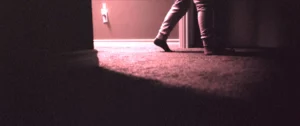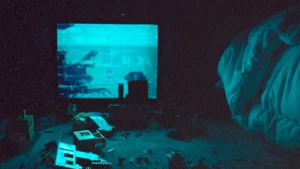Skinamarink (2023) review
Dir. Kyle Edward Ball
By: Steve Pulaski
Rating: ★★
The visceral, atmospheric qualities of the buzzy yet polarizing Skinamarink are difficult to ignore. For many people, Kyle Edward Ball’s film — which was leaked online last year and commanded such strong word-of-mouth, Shudder and IFC Midnight decided to release it in theaters — will serve as their introduction to analog horror. The subgenre mines feelings of fear and dread from the junk-drawer of technology: old VHS tapes, radios polluted by static, public access television, lo-fi video quality, and cryptic on-screen messages.
Any one of us who has stayed up way past our bedtimes to watch and decode episodes of Kris Straub’s Local 58 TV knows the powers of analog horror, and from all I heard about Ball’s feature upon seeing it, it appeared to be the next phenomenon in that space. However, as crafty as its visual poetry can get, and as committed to its experimental style as it is, Skinamarink runs long in the tooth and is liable to frustrate the average viewer due to its purposefully impenetrable presentation.

Ball got the idea for the film, which inspired his 2010 “proof of concept” short film Heck, when he ran a YouTube channel adapting submissions of users’ nightmares into short films. He claims that the premise of Skinamarink comes from a nightmare both him and countless other people experienced from the ages of six-to-10. Here’s the rub: two young children (Lucas Paul and Dali Rose Tetreault) awake in the middle of night to realize that their parents are gone and the doors and windows in their home have all vanished. Soon thereafter, other items begin disappearing, and it becomes increasingly clear these two children are not alone.
That’s about all there is to Skinamarink in terms of narrative. As film critic Brian Tallerico noted, Ball more-or-less institutes his own Dogme 95-esque rules on the project. For one, we never get a clear shot of anyone’s faces. The camera angles are frequently captured from a low-angle, canted downward either to obscure the object being shown or to present it in extreme close-up. Shots consist of dimly-lit hallways, ceilings, or small rooms only illuminated by a bright old tube television. Speaking of that television, on it are old cartoons from the 1930s and 1940s. The children put them on as background noise for coloring when they can’t locate their parents. The ordinarily silly, even relaxing music and animation of those shorts is rendered terrifying simply by the encroaching darkness and impending sense of dread.
Ball doesn’t seem to want you to interpret Skinamarink as much as he wants you to feel it. He wants to tap into that very real time in your childhood where you’re just aware enough to be scared but not mature enough to process how you’re feeling. That time you woke up in the middle of the night and realized you were alone, and every sudden movement, either by you or some unseen force, sent a jolt down your spine. Ball’s film is meant to experience.

Skinamarink has very little dialog, and what bit it does have is often conveyed via subtitles, either when the spoken-words are too quiet to be heard or otherwise not heard at all. For most of its 100-minute runtime, Ball’s film is a collection of lo-fi, canted angles of this home (his childhood home, actually), with awkward blocking and a logic-frying sense of place. “Weren’t we here before? Where did that come from? Is something going to happen?”
Unique movies call for unique circumstances, which is why I jumped at the opportunity to watch Skinamarink on Shudder while video-chatting with my girlfriend. Those were the kind of questions we threw up to one another while trying to discern what we were witnessing. Ball’s film might get better depending on your experience. I went through the trouble of waiting till nightfall, turning off all the lights in my apartment, and then settling in to watch this. Even then, my mind couldn’t help but drift and rift.
Being that Skinamarink offers nothing in the way of characters and no attempt to concretize what is happening on-screen, it is a frustrating sit. Lengthy static shots of hallways and careful pans underneath the bed don’t offer the viewer any kind of payoff. After an hour, the entire experience starts to feel like you are being served a tall glass of visual melatonin as opposed to a plate of creepypasta. Speaking of which, the excessive use of film grain and blurry blackness recalls those YouTube videos that my friends would show me. They’d watch my reactions in anticipation, waiting for that frightening face to suddenly appear and scare me half to death. I was probably in more suspense waiting for that obligatory demon creature to show himself in one of those videos than watching Skinamarink.
Even that ridiculous but admittedly jarring payoff was more than we get with this film. Atmosphere only goes so far, and this is material born to be anywhere from 20-70 minutes. At 100 minutes, it overstays its welcome and becomes a redundant exercise in minimalism. Despite my feelings, I do look forward to what Ball does next. A man confident enough to release something like this must have some other nightmares worth exploring.
NOTE: Skinamarink is now streaming on Shudder.
Starring: Lucas Paul, Dali Rose Tetreault, Ross Paul, and Jaime Hill. Directed by: Kyle Edward Ball.
About Steve Pulaski
Steve Pulaski has been reviewing movies since 2009 for a barrage of different outlets. He graduated North Central College in 2018 and currently works as an on-air radio personality. He also hosts a weekly movie podcast called "Sleepless with Steve," dedicated to film and the film industry, on his YouTube channel. In addition to writing, he's a die-hard Chicago Bears fan and has two cats, appropriately named Siskel and Ebert!


